Designing an Efficient U-Shaped Kitchen: A Guide
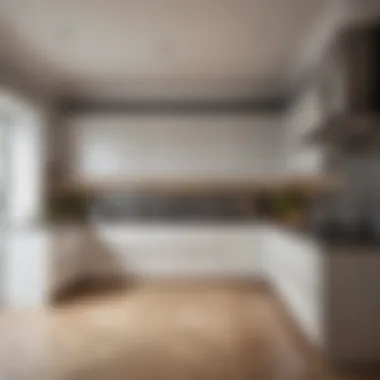
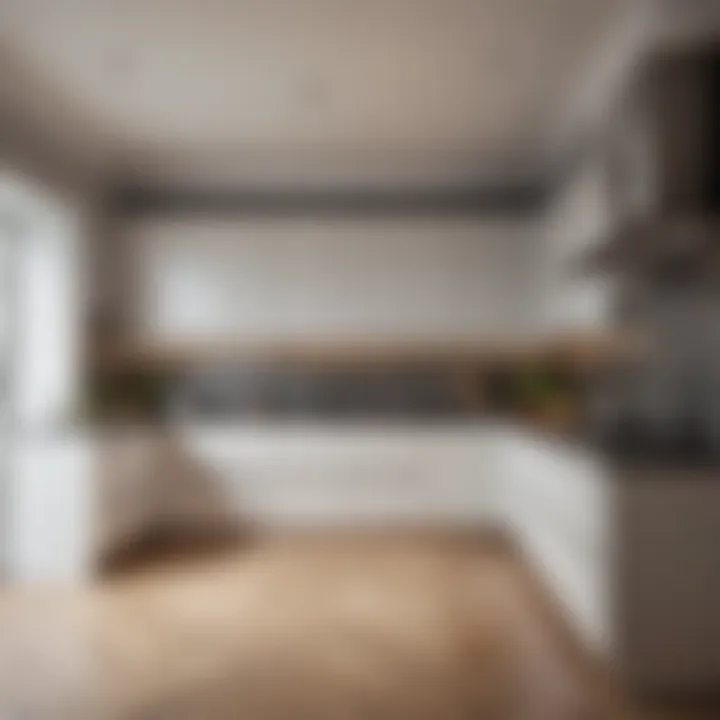
Intro
A U-shaped kitchen, often regarded as a favorite layout among homeowners and design enthusiasts alike, offers a blend of functionality and style. It mimics the shape of the letter "U" and usually comprises three walls of cabinets and appliances, creating an efficient workspace. The design isn’t merely about aesthetics; it’s about how the space flows and how you interact with it daily. One could say it represents a symphony of culinary creativity.
In this guide, we will delve into the intricacies of designing a U-shaped kitchen. From understanding the key components that contribute to an ideal layout to choosing the right materials and colors that resonate with your persona, we have you covered. Whether you’re rolling out flour for a pie or hosting a weekend soiree, getting it right pays dividends for both practicality and ambiance.
We’ll explore current trends that elevate this classic design, offering insights into innovative ideas that can make your kitchen not only a place for cooking but also a space for gathering and celebration. So, let’s jump in and start to lay the foundation for your dream kitchen!
Understanding the U-Shaped Kitchen Layout
When it comes to kitchen design, the layout significantly influences both aesthetic appeal and functionality. The U-shaped kitchen stands as a popular choice for many homeowners and design aficionados alike—for good reason. This configuration creates a natural flow, marrying the workspace with clever storage options.
The characteristic three-wall layout allows ample counter space and accommodates a range of appliances, ensuring every inch is utilized thoughtfully. Not only does this design maximize efficiency, but it also encourages a cozy environment, making it ideal for everything from casual meal prep to entertaining guests.
Characteristics of U-Shaped Kitchens
A U-shaped kitchen’s defining feature is, naturally, its shape. Comprising three sides of cabinetry with an open end, this layout provides a robust structure that supports both various cooking activities and family gatherings. Some key characteristics include:
- Workspace Galore: Being encased in three sides allows for extensive counter space, vital for chopping ingredients, assembling dishes, or even just laying out snacks for a soirée.
- Seamless Storage Solutions: With cabinets lining the walls, you can easily optimize vertical space for storage. This is especially helpful for compact areas where every bit of space counts. Many homeowners enhance this by using pull-out shelves or lazy Susans to access things easily.
- Breakdown of Zones: The U-shape enables the division of work areas into specific zones—culinary prep, cooking, and cleaning. This clear organization can reduce clutter and streamline tasks.
While this arrangement often suits both small and large spaces, consider the dimensions of your kitchen carefully. Ideally, the distance between the walls should be generous enough to avoid a cramped feel.
Benefits of Choosing U-Shaped Configurations
Opting for a U-shaped kitchen can pay dividends in terms of both functionality and style. Here are a few notable advantages that often attract homeowners:
- Enhanced Efficiency: With everything within arm's reach, the work triangle—defined by the stove, sink, and refrigerator—operates flawlessly, allowing chefs to glide from one task to another. This reduces unnecessary steps and increases overall efficiency.
- Integration of Modern Appliances: U-shaped kitchens easily accommodate larger appliances, such as double ovens or a sizable refrigerator, without hindering workflow. This flexibility is especially beneficial when prepping for a holiday feast or a family gathering.
- Social Hub: The open end of a U-shaped configuration naturally beckons gatherings. It’s an inviting space for friends and family to congregate, blurring the lines between culinary tasks and social interactions.
- Design Versatility: This layout seamlessly marries style with function, providing the perfect foundation for various interior design themes—from rustic farmhouse to sleek modern minimalist.
Overall, understanding the U-shaped kitchen layout equips you with the knowledge to optimize your cooking space effectively. Whether you are a passionate cook or the go-to party host, this design configuration has the potential to elevate your kitchen experience. As you embark on the journey of kitchen renovation, keep these elements in mind to create a functional and aesthetically pleasing environment.
Space Planning Considerations
When it comes to designing a kitchen, the layout is as crucial as the materials used. Utilizing a U-shaped kitchen layout can turn even the most modest of spaces into a culinary haven. In this section, the emphasis on space planning considerations cannot be understated. A well-thought-out approach to space planning can make a kitchen feel inviting, enhance efficiency, and accommodate multiple users seamlessly.
Measuring Your Kitchen Area
Before diving into the aesthetics or functionalities, it’s essential to take accurate measurements of your kitchen space. Start by noting down the length of each wall and the locations of windows and doors. This will lay the groundwork for your design.
- Height Matters: Don’t forget the height of the room. A higher ceiling can influence your choice of cabinetry and lighting fixtures.
- Shape of the Space: The U-shape works best in areas where three walls can be utilized effectively. A rectangular area can complement this layout wonderfully.
- Consider Clearance: Open pathways should be at least 42 inches wide for a comfortable experience in the kitchen. Remember, you'll want enough room for people to walk around each other, especially while multitasking.
- Object Positioning: Think about where appliances will be. Don't cluster the refrigerator and microwave too close together; give them breathing room so they can be accessed independently.
These measuring considerations are vital. Without them, you might end up with a kitchen design that’s more awkward than functional, making it a chore rather than a joy to cook.
Creating an Efficient Work Triangle
The kitchen work triangle is a popular concept in kitchen design that suggests arranging the stove, sink, and refrigerator into a triangle layout for maximum efficiency. Following this principle saves time and energy while cooking.
- Placement Matters: Each leg of the triangle should be between 4 and 9 feet. If the distance is too short, it could feel cramped; too long might make it cumbersome when going from one station to another.
- Workflow Efficiency: Let’s say you’re preparing a lavish meal for guests. Being able to move effortlessly from the sink to the chopping board, and then to the stove, without hitting a snag is a game-changer. It promotes smooth transitions, making cooking less of a hassle.
- Avoiding Obstacles: Keep the paths clear. No need for a dining chair to be stationed at the edge of the triangle so guests can grab drinks. Obstacles can slow down your process and create frustration.
"Good layout design is like a sleek dance between kitchen elements—flowing, efficient, and pleasing to the eyes.”
In summary, space planning is where the magic starts in a U-shaped kitchen. Accuracy in measuring, thoughtful positioning, and an adherence to the work triangle principle will foster an efficient and enjoyable cooking environment. This foundation is what ultimately transforms a space from merely functional into truly exceptional.
Selecting Essential Kitchen Appliances
When designing a U-shaped kitchen, the right appliances are pivotal. They not only affect the kitchen's functionality but also influence its overall aesthetic. Selecting essential kitchen appliances involves striking a balance between size, convenience, and energy efficiency, ensuring that your kitchen operates smoothly.
Choosing Appropriate Sizing
The size of kitchen appliances in a U-shaped setup can be a make-or-break factor in how well the space works. A common temptation is to buy the latest larger models, thinking that bigger is better. However, in a confined kitchen layout, you might find that a compact appliance does just as good a job while leaving more room to move.
- Measure your space: Before making any purchases, always measure the designated areas in your kitchen. This includes the available width between counters and the height of cabinets. Appliances should fit comfortably without restricting movement.
- Consider usage: Think about how often you'll use each appliance. A generous oven might be essential for enthusiasts who enjoy baking. In contrast, a smaller microwave could suffice for those heating leftovers. This consideration also helps avoid cluttering the space with unnecessary items.
- Standard Sizes: Familiarize yourself with standard kitchen appliance sizes, as these are often designed to fit seamlessly into U-shaped configurations. Knowing these standards can guide your choices and help you avoid misfits later on.
"The right appliance size can turn a cramped space into a functional haven."
Integrating Energy-Efficient Options
Incorporating energy-efficient appliances is not just a trend; it's a crucial decision for sustainability and cost-effectiveness. When selecting your kitchen gadgets, look for the Energy Star label which indicates that the appliance meets energy efficiency guidelines set by the U.S. Environmental Protection Agency. Here are some benefits and considerations:
- Reduced utility bills: Energy-efficient appliances consume less electricity, translating to savings on your monthly bills. This becomes particularly valuable if you often use multiple appliances at once.
- Environmentally friendly: Opting for eco-friendly options contributes to reducing your carbon footprint. Equipment using less energy typically has a more positive impact on the environment.
- Smart features: New models often come equipped with smart technology that aids in energy management, like sensors that adjust energy use based on cooking needs. These can be a boon for both convenience and efficiency.
- Long-term investment: While these options may come with a higher upfront cost, the savings over time can often justify the initial expense, making them a wise long-term investment.
In summary, selecting appliances tailored to your needs and space will enhance the practicality and style of your U-shaped kitchen. With thoughtful sizing and a commitment to energy efficiency, your kitchen can function not only as a cooking space but also as an inviting gathering area.
Choosing Kitchen Materials
Choosing the right materials for your kitchen is more than just a style choice; it shapes the durability, functionality, and overall aesthetic of the space. In a U-shaped kitchen, where everything is in neatly packed zones, the materials you pick play a vital role in how you interact with your kitchen every day. Durable surfaces that can withstand heat, spills, and daily wear-and-tear contribute to a kitchen that stands the test of time, while the palette can make your cooking space feel inviting or sterile.
With focus on both function and flair, it's key to weigh your options carefully. Consider not only how materials look but how they support your lifestyle. Are you an avid cook or more of a takeout aficionado? Each lifestyle demands different features from materials, guiding your choices.
Countertops: Functional and Stylish Choices
When it comes to countertops, you're not just selecting a surface to chop vegetables or set down hot dishes. It’s about creating a focal point that defines the kitchen’s personality while being practical.
- Materials Matter:
- Granite: Known for its timeless beauty and toughness. However, it's porous and requires sealing to prevent stains.
- Quartz: This engineered stone offers a wide choice of colors and patterns, while being non-porous and easier to maintain.
- Butcher Block: Perfect for dedicated home chefs, it encourages a warm, organic feel but needs regular upkeep to avoid damage.
- Laminate: A budget-friendly choice, laminate can mimic more expensive materials but might not withstand heat as well.
The countertop should resonate with your cooking habits and aesthetic preferences. You wouldn’t want to pick a hissy-fit marble if you know you’re going to be messy in the kitchen, right?
Cabinetry: Finishes and Styles
Cabinetry plays a monumental role in defining the look and feel of your U-shaped kitchen. Beyond organization and storage, it signifies your style.
Use these considerations to mindfully pick your cabinets:
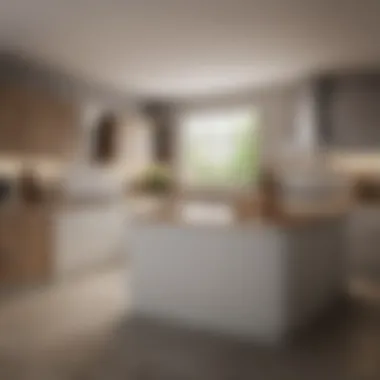
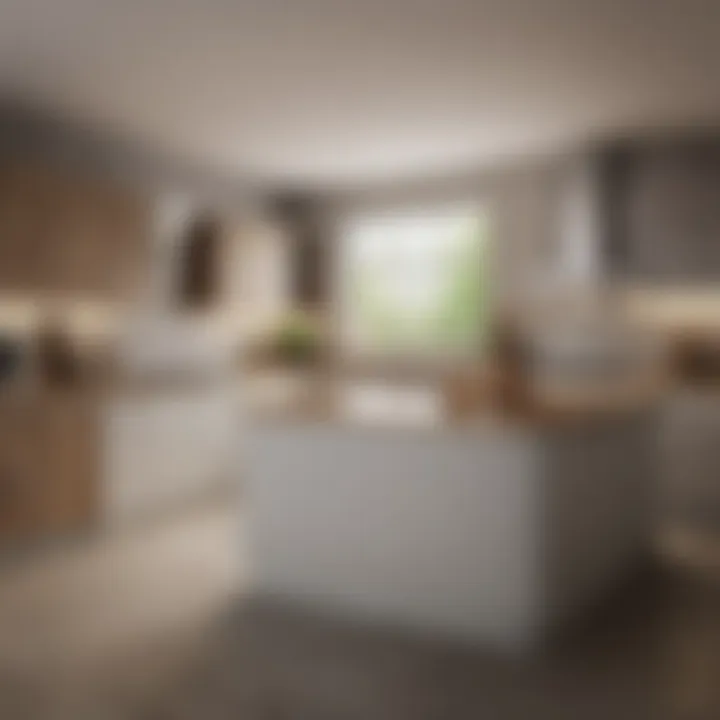
- Material Choices:
- Finishes:
- Wood: Solid wood gives great character, but can expand and contract with humidity. Decide on hardwood for longevity.
- MDF or Particleboard: Often cheaper options, these can be made more durable with a quality veneer finish.
- Painted vs. Stained: Painted cabinets can create a fresh feel, while stained finishes highlight the wood grain. Think about your color scheme!
- Glossy vs. Matte: Glossy finishes reflect light and can make the kitchen feel larger, while matte brings in warmth. Which vibe are you going for?
The aim is to create a seamless flow between the cabinetry and other elements in your kitchen, contributing to both function and style.
"The materials you choose are the unsung heroes of your kitchen’s story — they not only support your culinary activities but also reflect who you are at home."
Picking the right materials for your U-shaped kitchen isn’t a task to be taken lightly. Each decision adds to the final picture, contributing to both the practical usability and the overall style of your cooking haven. By understanding your own needs and aligning them with practical options, you can create a kitchen that is truly a delight to use and show off.
Color Schemes and Aesthetic Choices
Selecting the right color scheme and aesthetic choices for your kitchen can feel like assembling a puzzle—there's a need for balance, coherence, and a dash of personality. In a U-shaped kitchen, which naturally encourages flow and interaction, your color choices can enhance functionality as well as create an inviting atmosphere.
Importance of Color Schemes
Color impacts mood, perception of space, and even functionality within the kitchen. By introducing a well-thought-out palette, homeowners can make their kitchens feel larger, brighter, or more intimate. For example, light hues like soft whites or pale blues can reflect natural light, giving the impression of a more expansive area. On the flip side, richer shades like deep greens or vibrant terracotta can add warmth and a contemporary feel, enticing family and guests to gather.
When choosing colors, it’s vital to consider how they will interact with both natural light and the materials used throughout your kitchen. Mismatched schemes can cause visual confusion, while a harmonious palette can evoke calm and cohesiveness.
Balancing Color with Natural Light
Natural light plays an essential role in your kitchen design, affecting how colors appear throughout the day. With U-shaped kitchens often designed to open up toward windows or other light sources, understanding the interplay of light and color becomes critical.
Evolving our earlier example, consider how different times of day can alter a space. Morning sun, dappled through sheer curtains, can cast a warm glow, making cooler blues appear fresher and livelier. Alternatively, in the soft light of evening, those blues might take on a more muted tone, lending the room a calmer ambiance.
To optimize color balance with natural light:
- Sample Your Paint: Always test your color selections in natural lighting before committing.
- Use Reflective Surfaces: Glossy cabinets or countertops can help bounce light around, enhancing color vibrancy.
- Layered Textures: Mix materials like wood and metal, which can create depth against your chosen color backdrop.
“Color is a power which directly influences the soul.” – Wassily Kandinsky
Creating Visual Contrast and Harmony
Creating contrast involves setting up a dialogue between your colors—not just in an aesthetic sense, but also functionally. With a U-shaped kitchen layout, contrasting colors can define different zones, making it easy for family members or guests to navigate the space.
Consider these tips when designing for contrast and harmony:
- Opposing Colors: Pair complementary colors, such as navy blue with coral, to draw attention to certain areas without overwhelming. This strategy adds dynamism to the kitchen.
- Accent Pieces: Use decorative items, like artwork or vibrant dishware, to introduce bursts of color that can break up monotony.
- Consistent Materials: Ensure that while colors may contrast, the materials used maintain a consistent quality to tie the design together. For instance, if you choose a glass tile backsplash in a bold red, carry that red into functional elements like placemats or dish towels for a unified appearance.
Ultimately, you have the creative freedom to cultivate a kitchen that not only serves its purpose but also reflects your personal style. Choosing and balancing colors thoughtfully can transform your U-shaped kitchen into a magnet for gatherings and daily efficiency.
Optimizing Storage Solutions
When designing a U-shaped kitchen, it’s often the little things that make a massive difference. One of those elements is storage solutions. Optimizing storage isn't just about having enough space; it’s about making sure your kitchen functions as smoothly as a well-oiled machine. The layout’s natural boundaries help define distinct zones, but without proper storage, even the most beautiful kitchen can feel cluttered and chaotic.
Why is optimizing storage important? Storage integrates both practicality and aesthetics. A functional kitchen needs to accommodate various items like pots, pans, and utensils. Without effective solutions, everyday essentials may end up scattered everywhere, leading to frustration during meal prep. It’s essential to create systems that are not only efficient but also easy to maintain.
Here are a few key considerations to keep in mind:
- Accessibility: Items should be easy to reach.
- Organization: Use dividers and labeled containers to keep things tidy.
- Utilization of nooks: Think outside the box and use every bit of available space.
Investing effort into optimizing storage solutions paves the way for a clean, organized, and inviting kitchen space. A well-structured kitchen not only improves workflow but also enhances overall enjoyment of the cooking journey.
Maximizing Vertical Storage
Vertical space is often overlooked in kitchen design, but if you don’t utilize it, you’re leaving a treasure trove of potential behind! In a U-shaped kitchen, vertical storage can be a game changer, allowing you to keep countertops free from clutter while efficiently storing kitchenware.
Here’s how to maximize vertical storage:
- Shelving: Install floating shelves to hold items you use often – spices, cookbooks, or even decorative pieces. A visual appeal and function combined!
- Cabinet Height: Opt for taller cabinets that reach up to the ceiling. This can give you extra storage and make a room appear larger.
- Hanging Racks: Consider hanging pots and pans or even utensils. This can save drawer space and make cooking a breeze.
By making the most out of the vertical elements of your kitchen, you can achieve a clean, streamlined look. Plus, it frees up valuable space for food prep, cooking, and entertaining.
Incorporating Multi-Functional Furniture
In today’s fast-paced world, multi-functional furniture has become a staple in modern kitchen designs. A U-shaped kitchen is a prime candidate for this approach. The idea behind incorporating multi-functional pieces isn’t just saving space; it’s about maximizing utility.
Here are some top recommendations:
- Kitchen Islands: If space allows, consider a kitchen island that can double as a dining area. This way, it enhances social interactions and redefines how we view the kitchen.
- Storage Benches: These can serve as seating while providing hidden storage for items like table linens or small appliances.
- Extendable Tables: In case you love hosting dinner parties, an extendable table can offer seating flexibility without occupying a lot of space.
Incorporating multi-functional furniture isn’t merely a trend; it enhances both functionality and style in a U-shaped kitchen, proving that less can be more.
A combination of maximizing vertical storage and opting for versatile furnishings sets a robust foundation for any kitchen, creating an environment that supports creativity and efficiency. In the larger picture, thoughtful storage solutions elevate both daily experiences and special moments.
Efficient storage is not just a requirement; it is an art form that significantly influences kitchen dynamics.
Lighting Design for U-Shaped Kitchens
Lighting design holds significant weight in the overall functionality and ambiance of a U-shaped kitchen. Given the spatial configuration of this layout, effective lighting enhances not just visibility but also the kitchen's aesthetic appeal. A well-lit kitchen enables safe cooking and food preparation, while creating an inviting atmosphere for gatherings and everyday activities. The right lighting choices can make a space feel larger, brighter, and more welcoming—all key aspects for an efficient kitchen.
Layering Different Lighting Types
To achieve a balanced and effective lighting scheme, layering different types of lighting is essential. This usually encompasses ambient, task, and accent lighting:
- Ambient Lighting: This serves as the general illumination for the room. Think of fixtures like ceiling-mounted lights, recessed lighting, or even large pendant fixtures that provide an overall glow. For a U-shaped kitchen, a mix of overhead fixtures can make a world of difference, filling the space with a soft glow that’s neither harsh nor dim.
- Task Lighting: This is where specific zones in the kitchen are illuminated for particular activities. Installing under-cabinet lighting can make prepping and cooking tasks smoother. When chopping vegetables or sautéing onions, having focused light falls in just the right spot can alleviate strain and help prevent accidents.
- Accent Lighting: This type of lighting adds character to the kitchen. Consider highlighting decorative elements, like a beautiful backsplash or specially designed cabinetry. Small LED spotlights or soft-lit wall sconces can draw attention to these features, making the kitchen visually stimulating.
Layering these three lighting types not only increases functionality but also adds depth and interest to the room. The dance of light can highlight the dynamic elements within a U-shape and transform a simple kitchen into an impressive culinary oasis.
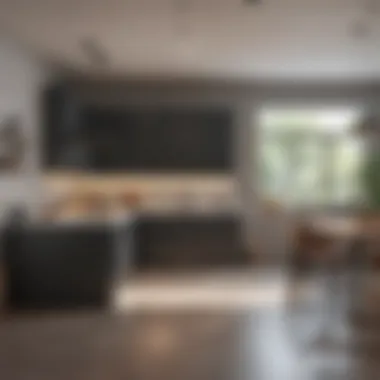
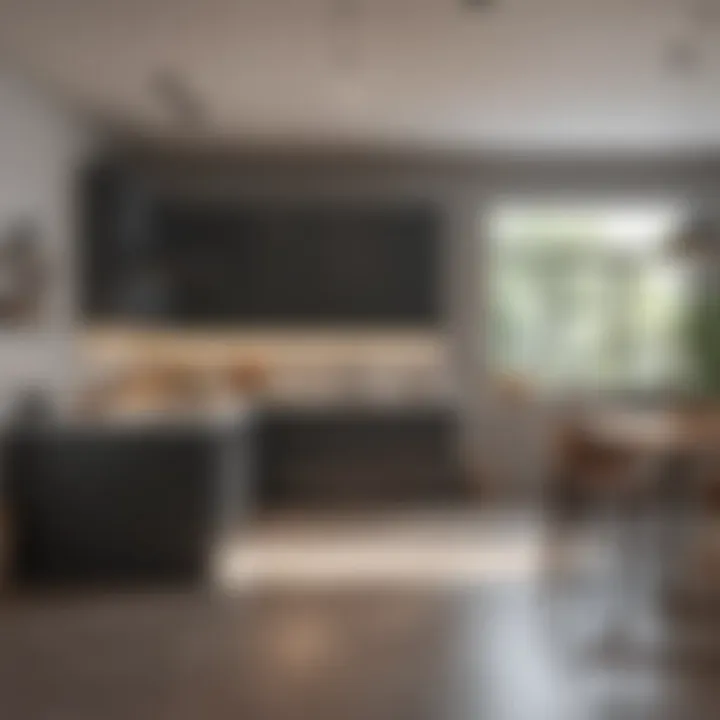
Positioning Lighting Fixtures Effectively
After understanding the types of lighting, effective fixture placement is crucial. It's not just about having adequate light; it’s about having it in the right places. Here are several considerations:
- Focus on Workflow Areas: For a U-shaped kitchen, the corners and areas centrally located within the triangle formed by the sink, stove, and refrigerator require particular attention. Light fixtures should be strategically positioned to eliminate shadows and ensure that the main work zones are well-lit.
- Height Matters: When hanging pendants or chandeliers, be mindful of the height. A common rule of thumb is to hang pendant lights about 30 inches above the countertop. This height offers adequate illumination without obstructing views.
- Use Dimmers for Flexibility: Installing dimmer switches gives control over the ambiance. Depending on the time of day or the occasion, you can easily adjust the brightness to suit your needs. If you��’re hosting a dinner party, you may want softer lighting to create a cozy vibe, while brighter settings may be preferred during meal prep.
"Proper lighting design can redefine how you perceive and use your kitchen, enhancing not only its productivity but also the comfort of its environment."
By taking into account both the types of lighting and their placement, homeowners can achieve a well-lit U-shaped kitchen that serves both practical demands and emotional experiences. The goal is to create a harmonious blend of lighting that transforms an ordinary kitchen into a lively, functional space.
Integrating Technology in Kitchen Design
In today's fast-paced world, kitchens aren't just about cooking anymore. They’ve transformed into multifunctional spaces where technology plays a pivotal role. Integrating technology into your U-shaped kitchen design can yield not just convenience but also enhance the overall functionality and aesthetic appeal. With gadgets and systems advancing at lightning speed, the modern kitchen can be tailored to fit the specific needs of each owner, making meal preparation, storage, and even cleaning far more efficient than ever before.
Smart Devices for Improved Efficiency
Smart devices have become the backbone of a modern kitchen, where each gadget introduces a new level of utility. Imagine having a refrigerator that can alert you when supplies are running low or an oven that allows you to preheat remotely. Not to mention, smart dishwashers can save you a heap of time and energy, with some being able to operate during off-peak utility times to conserve electricity.
- Interactive Displays: Many kitchen appliances now come equipped with touch screens that not only help in selecting settings but also provide access to recipes or cooking videos right at your fingertips.
- Multi-Functional Tools: Devices such as air fryers and pressure cookers can cut down cooking times while providing healthier meal options. These gadgets combined with smart features can make a busy lifestyle bearable.
- App Connectivity: There’s nothing like controlling your kitchen from your smartphone. Whether it’s adjusting your oven's temperature or checking on your slow cooker, app connectivity adds a layer of convenience.
Ultimately, these smart devices not only contribute to efficiency but also save time, allowing for a more relaxed cooking experience.
The Role of Home Automation Systems
Home automation systems bring further sophistication into kitchen design, allowing you to integrate various aspects of your home into one cohesive ecosystem. This means you can control everything from lighting to climate directly from your smartphone or even through voice commands.
- Lighting Control: Imagine dimming your kitchen lights before dinner or brightening them for a busy breakfast hustle, all with simple voice commands or automated schedules.
- Temperature Regulation: A smart thermostat can ensure your kitchen remains comfortable throughout the day. You might want it cooler for cooking but warmer during those cozy gatherings.
- Remote Monitoring: Home automation systems allow you to check on your appliances or even see who's at the door, enhancing safety and convenience while you're multitasking in your kitchen.
In summary, integrating technology into your U-shaped kitchen design isn't just a trend; it’s a smart way to elevate your culinary space for efficiency and enjoyment, making your daily grind a whole lot easier and more organized.
"A well-designed kitchen with integrated technology can change not just how we cook but also how we gather and connect with family and friends."
Thus, as you venture into crafting a U-shaped kitchen, considering these tech advancements can seamlessly blend sophistication with practicality.
Creating a Functional Workflow
Designing a U-shaped kitchen goes beyond just aesthetics; the practical aspects are equally paramount. Establishing a functional workflow is crucial in ensuring that the kitchen serves its purpose efficiently. A well-thought-out workflow optimizes the process of cooking and cleaning, leading to a more enjoyable experience in the kitchen. When every task flows seamlessly into the next, you can cook not just with skill but also with joy.
Streamlining Cooking and Preparation Areas
To streamline cooking and preparation areas, you first need to consider the kitchen work triangle. This concept involves optimizing the distance between the sink, stove, and refrigerator—essential zones that are frequently used during meal preparation. By minimizing the distance, you foster a more efficient workflow. Moreover, think about incorporating large countertops or islands that allow you to lay out ingredients without crowding your workspace.
- Ample Counter Space: Create dedicated zones for chopping, mixing, and assembling. This prevents clutter and allows you to work swiftly.
- Smart Storage: Keep frequently used tools and ingredients within easy reach. Using pull-out shelves and drawers can save time during cooking, helping to prevent unnecessary trips to cabinets.
- Zoned Lighting: Ensure cooking areas are well-lit. Zone lighting not only enhances visibility but also sets the mood during meal preparations.
Taking time to organize these areas will allow you to whip up meals with little fuss, enabling you to spend more time enjoying the food and less time wrestling with a cluttered kitchen.
Designing Efficient Clean-Up Spaces
Clean-up spaces are often an afterthought, but they play a pivotal role in maintaining workflow efficiency. If the clean-up process is streamlined, you'll find an invigorated enthusiasm for cooking, as there won’t be a dreaded aftermath waiting to greet you.
- Adjacent Sink Location: Position the sink close to the cooking and preparation areas. This proximity saves crucial time when washing hands, rinsing vegetables, or cleaning pots and pans.
- Functional Dish Drying Solutions: Invest in drying racks or built-in drainboards to keep your clean dishes organized and out of the way. This adds efficiency and tidiness at the same time.
- Integrated Trash Solutions: Incorporate space for waste bins within arm's reach of your prep area. Pull-out bins or designated compartments in cabinets keep the kitchen clean and organized, enabling you to toss scraps easily.
The aim is to make clean-up as effortless as possible. By prepping for messes while cooking, you pave the way for a kitchen that works with you, rather than against you.
Remember: A functional workflow reshapes the kitchen experience, transforming it into a hub for creativity rather than a chore. Balancing cooking and clean-up leads to a more harmonious atmosphere.
Incorporating Personal Style
When it comes to kitchen design, the importance of incorporating personal style cannot be overstated. A kitchen is more than just a place to prepare meals; it serves as the heart of the home, where friends and family gather. Ensuring that your kitchen reflects your personality and taste can turn a standard cooking space into a cozy gathering place. This section explores how personal style influences kitchen design, and offers practical insights on how to imbue your U-shaped kitchen with your unique flair.
Infusing Unique écor Elements
Unique décor elements play a pivotal role in expressing personal style. Whether it’s a vibrant backsplash that sings with color or quirky accessories that tickle the fancy, every element contributes to the overall aesthetic. Consider the following suggestions to add your signature touch:
- Artwork: A well-placed piece of art can enhance the kitchen’s ambiance. Opt for a colorful print or even a local artist's work to bring life to your walls.
- Personalized Accessories: Items such as custom dishware or personalized cutting boards can make a big difference. It’s these little details, after all, that showcase your taste and personality.
- Cultural Touches: If your heritage plays a significant role in your life, using decor that reflects your roots can make the space feel more intimate. Think traditional pottery or fabrics that resonate with your family’s background.
Incorporating these elements helps to weave your story into the very fabric of your kitchen, creating a space that is not only functional but also deeply personal.
Curating a Personalized Kitchen Experience
Creating a personalized kitchen experience goes beyond aesthetics; it also encompasses functionality tailored to your lifestyle. Every family has its rhythm, and your kitchen design should facilitate that. Here are some actionable ideas:
- Tailored Layouts: Depending on your cooking habits, consider how the kitchen layout can promote an enjoyable culinary experience. If baking is your forte, having a dedicated baking station with easy access to tools is a smart move.
- Flexible Spaces: Integrate flexible spaces where family members can gather. A cozy nook with cushions or a bar area where guests can sit and chat while dinner is prepared can forge connections.
- Smart Storage: Reflect on how you use your kitchen items. Custom storage solutions, such as pull-out spice racks or slide-out bins, can optimize space and keep everything organized, making your kitchen truly function as an extension of your lifestyle.
Curating a personalized kitchen experience means designing a space that not only looks good but also serves your day-to-day needs effectively. It is all about creating that sweet spot where style meets usability.
The kitchen should serve as a canvas for self-expression, inviting you and your guests to create memories in a space that feels uniquely yours.
Sustainable Kitchen Design Practices
In the ever-evolving world of home design, sustainability stands as a pillar of modern practice. When it comes to kitchens, where functionality meets creativity, embracing sustainable design practices not only benefits the environment but also enhances the kitchen's long-term efficiency and aesthetic appeal. Homeowners today are more aware of their carbon footprints, leading them to consider options that prioritize eco-friendliness alongside functionality. This section delves into how integrating sustainable practices in your U-shaped kitchen can yield significant advantages, both for you and the planet.
Material Choices with Low Environmental Impact
Choosing the right materials is critical. Opting for materials with low environmental impact is one of the first steps toward crafting a sustainable kitchen. This means selecting items that are sourced responsibly and can stand the test of time without harming the ecosystem.
Here are some ideal options to consider:
- Bamboo: A fast-growing plant, bamboo serves as a sustainable alternative to traditional wood. Its strength and resilience make it perfect for countertops and cabinetry.
- Reclaimed Wood: Using reclaimed wood not only reduces waste but also infuses your kitchen with unique character. Each piece tells a story. Every scratch and dent adds to its charm.
- Recycled Glass: For countertops or backsplashes, recycled glass can provide a stunning visual effect while minimizing demand for new raw materials. Its vibrant colors and patterns can elevate your kitchen’s aesthetics.
- Low-VOC Paints and Finishes: Volatile organic compounds can harm indoor air quality. Low-VOC options ensure that your kitchen remains healthy and safe while looking fabulous.
Remember that selecting materials shouldn't just be about looks; they should withstand the test of daily life too.
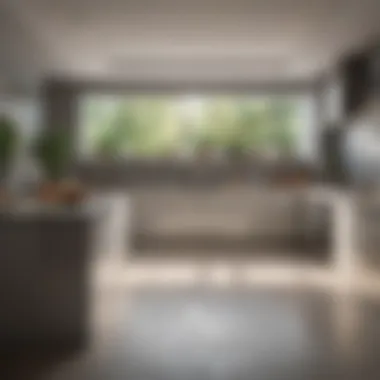
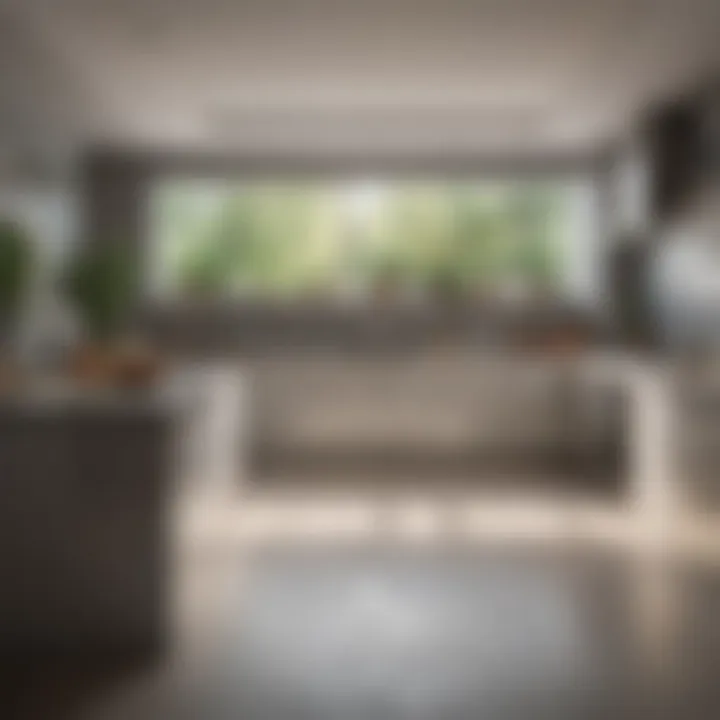
Implementing Energy-Saving Strategies
Once material choices are sorted out, the next crucial area is implementing energy-saving strategies that can complement your U-shaped kitchen's design. These strategies not only lower energy bills but also promote responsible energy use, which is especially crucial in the kitchen where energy consumption tends to be high. Here are some effective ways to do this:
- Energy-Efficient Appliances: When replacing old appliances, look for those certified by the Energy Star program. These devices consume less energy, saving you money and reducing environmental impact. Think long-term savings here.
- LED Lighting: Swapping out traditional bulbs for LED lighting can significantly decrease electricity use. LEDs last longer too, which means fewer replacements contribute to waste.
- Smart Thermostats: Installing smart thermostats simplifies monitoring your kitchen’s temperature, allowing for more efficient heating and cooling when needed. Control your temperature to save energy effortlessly.
- Sealing and Insulating: Ensure that all doors and windows are properly sealed. Proper insulation coupled with energy-efficient windows minimizes heat loss and can lead to substantial energy savings.
Incorporating these strategies can transform your kitchen into an eco-friendly haven, letting you enjoy cooking and entertaining with peace of mind.
"Sustainability is not a trend; it’s a necessity for a better tomorrow."
By marrying style and sustainability, your U-shaped kitchen not only becomes a space for culinary creativity but also a statement of your commitment to the environment.
Budgeting for Your U-Shaped Kitchen
When embarking on the journey of designing a U-shaped kitchen, budgeting emerges as a foundational element that cannot be overlooked. Crafting a financial blueprint is not merely about limiting expenses; it is about strategically navigating the complexities of kitchen design while ensuring that you achieve both function and aesthetic appeal. A clear budget helps in making informed decisions that align with your vision, whether you're a homeowner looking to elevate your space or an interior design enthusiast seeking the latest trends.
Establishing a Clear Financial Plan
To kick things off, laying out a financial plan will guide you through the myriad decisions ahead. Begin by calculating your total budget, which reflects the amount you are comfortable investing into the kitchen. This sum should cover everything from appliances to finishes, encompassing each component of your design.
- Assess your available funds: Determine how much cash you can access. If you’re planning to finance the renovation, check for interest rates that won’t break the bank later on.
- Break it down: After you have your total, break the budget down into categories. How much do you wish to spend on cabinetry, countertops, and appliances? An even more granular approach includes allocating funds for smaller fixtures and hardware as well.
"A well-planned kitchen renovation can boost not only the value of your home but also your overall satisfaction with the space."
Creating an itemized budget helps you keep track of your finances. There may be unexpected costs along the way. Having a buffer of about 10-15% of your overall budget for surprises can save a lot of headaches later.
Prioritizing Key Expenses and Features
Once you have your financial plan laid out, it’s time to prioritize expenditures. What elements are essential for your kitchen’s functionality and visual appeal? Here is how to approach it:
- Identify must-haves versus nice-to-haves: Make a list marking the critical elements that will impact your kitchen's workflow. Top-tier appliances might be essential if you’re an avid cook, while elaborate lighting fixtures could be more optional.
- Invest in quality where it counts: Sometimes, it's worth splurging on elements like countertops or cabinetry. If these materials are durable and timeless, they could save you money over years due to reduced replacement needs.
- Consider labor costs: Don’t neglect the importance of hiring professionals for installations. Skilled labor can often save time and prevent costly missteps.
By clearly prioritizing aspects of your kitchen's design, your funds will be allocated toward features that resonate most with your needs and lifestyle. In turn, this focused expenditure will lay the groundwork for both functionality and style, ensuring that your U-shaped kitchen stands not just as a space for cooking, but as a heart of the home.
Finalizing your Kitchen Design
As you approach the final stages of crafting your U-shaped kitchen, take a moment to recognize the significance of this phase. It’s the moment where all your meticulous planning and creative choices crystallize into a cohesive design. An effective finalization process not only confirms that the practical aspects align with your vision, but also ensures that every element contributes to a functional and visually appealing space. In this section, we will delve into two critical aspects of this process: double-checking your layout and flow, and preparing for construction and installation.
Double-Checking Your Layout and Flow
Before the hammers swing, it’s essential to revisit your kitchen layout. This stage might appear mundane, but it can be a game changer. Consider this: one poor design choice can turn your culinary haven into a frustrating maze. Take time to evaluate the relationship between key areas—cooking, cleaning, and storage. A smooth flow means fewer steps back and forth, making your kitchen more efficient and enjoyable to work in.
To properly review your layout, keep the following in mind:
- Work Triangle: Ensure that the distance between your stove, refrigerator, and sink complies with common triangular workstation guidelines. Ideally, this distance should be between 12 to 26 feet, optimizing both movement and functionality.
- Space for Movement: Cluttered pathways can lead to accidents. Ensure at least 42 inches of clearance in passageways to maintain easy movement.
- Accessibility: Check if all cabinets and appliances are conveniently reachable. Elements such as a pull-out pantry or a lazy Susan in corner cabinets can greatly improve accessibility.
"Your kitchen’s flow should feel natural, guiding you effortlessly from one task to another."
Preparing for Construction and Installation
Once all details are meticulously checked and re-checked, it’s time to gear up for the construction phase. Getting this right can save you from headaches down the line. Preparation involves more than just picking up tools; it also requires a well-laid plan, particularly when it comes to the timing of tasks.
Here are key considerations to contemplate during this stage:
- Develop a Detailed Timeline: Create a comprehensive timeline outlining when different tasks need to occur. It prevents overlap and keeps everyone on the same page.
- Hire Professional Help: Depending on your comfort level, consider employing skilled tradespeople for plumbing, electrical work, or any structural changes. Their expertise can help avert potential pitfalls and costly mistakes.
- Source Materials in Advance: Ensure that all materials like cabinetry, countertops, and appliances are ordered well beforehand. Delays in supply can push back your project significantly.
- Establish a Safety Plan: Prioritize safety in your kitchen renovation. This includes moving furniture and protecting surfaces from potential damage during construction.
By now, the pieces of the puzzle should be in alignment. Taking these steps ensures you’ve double-checked your design and prepared meticulously for the next chapters of your kitchen journey. Before you know it, the dream kitchen you’ve envisioned will be just within reach.
Coping with Renovation Challenges
Renovating a kitchen is no small feat, especially when it’s a U-shaped design that often requires thoughtful planning and strategic execution. It's one of those situations where you can't afford to cut corners. The success of your kitchen remodel greatly depends on how well you anticipate the hurdles that may arise.
One common consideration is knowing that disruptions in your routine might feel like a storm in a tea cup. Kitchens serve as the heart of the home, and when they’re out of commission, it can throw everything off balance. Understanding potential challenges helps to mitigate stress and allows for a smoother renovation process. This section will illuminate not only the difficult scenarios but also how to navigate through them effectively.
Common Design Pitfalls to Avoid
A well-executed design is essential for maintaining an efficient U-shaped kitchen. However, it is all too easy to fall into common traps that can lead to dissatisfaction.
- Ignoring Workflow: One major pitfall is neglecting to consider how the kitchen workflow functions. Avoid clumping all appliances too closely or misplacing essential items. The triangle design – refrigerator, stove, and sink – need to be appropriately spaced and easily accessible.
- Overlooking Lighting Needs: Underestimating the impact of lighting can turn a beautiful design into a dark cave. Ensure that your lighting fixtures illuminate all corners of the kitchen, providing both task and ambient lighting.
- Underestimating Storage: Skimping on cabinets or drawers can lead to chaos. Always plan for more storage than you think you’ll need. Measure what you have now and double it if possible.
- Focusing Solely on Aesthetics: While a pretty kitchen is wonderful, function should not be secondary. Mixing beauty with practicality is key to a successful renovation.
Strategies for Successful Renovation Management
Successfully managing a kitchen renovation requires more than just an eye for design—it's a comprehensive process that necessitates various strategies to stay in control.
- Develop a Timeline: Without a timeline, your project may seem like a runaway horse. A well-structured schedule keeps the renovation on track, allowing for adjustments if work unexpectedly drags.
- Stay Within Your Budget: Financial management can make or break a renovation. Establish a clear budget from the get-go, and include a buffer for unexpected expenses. You'll be grateful for it when the water heater gives up right after you’ve splurged on new cabinets.
- Communicate with Contractors: Keep lines of communication open with your contractors. Regular check-ins help to clarify expectations and catch any problems before they snowball.
- Flexible Mindset: Accept that sometimes storms happen. A tile you ordered might arrive broken, or you might change your mind about a finish. Adaptability ensures that minor hiccups don’t derail the entire project.
The road of renovation can be bumpy, but equipping yourself with awareness and strategies generates a smoother experience. Prior planning is essential, leading you straight to the kitchen of your dreams.
Reflecting on Your Kitchen Experience
In the process of designing a U-shaped kitchen, many homeowners often overlook the importance of reflection after the space is functional. Reflecting on your kitchen experience can significantly enhance usability, aesthetics, and overall satisfaction in the long run. It’s about stepping back and assessing how well the kitchen works for daily activities while also evaluating the emotional connection to the space. After all, a kitchen isn’t just a cooking area; it's often the heart of the home—a place where gatherings occur, meals are shared, and memories are created.
Evaluating Functionality and Performance
To ensure that your new kitchen layout serves your needs effectively, it is vital to evaluate its functionality and performance. This process should take into account various elements such as:
- Workflow Efficiency: Analyze how smoothly your cooking, cleaning, and prep tasks flow. Are the appliances and countertops strategically located? A well-thought-out work triangle can save considerable time.
- Storage Solutions: Reflect on the adequacy of your storage. Can you easily access your pots, pans, and utensils? Consider whether high shelves or lazy Susans aid in keeping things organized and reachable.
- Overall Comfort: Assess how comfortable you feel when navigating the kitchen. Ample space between the counters and the kitchen island is essential. Feeling cramped can stifle creativity and enjoyment when cooking.
This evaluation might lead you to rethink certain decisions. Maybe you realize you need more countertop space or that a better oven placement would enhance your cooking experience. Understanding these functional aspects is crucial; they're the backbone of a kitchen that works.
Gathering Feedback for Future Improvements
After you’ve settled into your U-shaped kitchen, gathering feedback is equally important. Engaging housemates, family members, or even friends who frequently visit can provide a fresh perspective.
Here are some points to consider:
- What Do They Like?: Discover what aspects of the kitchen stand out as positive features. Is it the flowing space? The natural light? Understanding what works helps affirm your designer choices.
- What Are Their Pain Points?: Harsh as it may sound, weaknesses in the kitchen can often be highlighted by others more than yourself, since you may become accustomed to its quirks. Pay attention to repeated comments about limitations like accessibility issues or awkward kitchen traffic patterns.
- Future Needs: Life changes quickly. Whether it's an interest in more frequent entertaining or cooking for a larger family, discussing future needs can help you envision improvements.
The feedback phase is not just about listening but also about adapting the kitchen design to evolve with your lifestyle. By implementing changes based on this feedback, you not only increase the functionality but also enhance the emotional resonance of the kitchen space—all while ensuring that it remains an enjoyable hub for family gathering.







